
In Korea, that refers to music from the Korean peninsula, ranging from prehistoric times to the division of Korea into South and North in 1945. It includes court music, folk music, poetic songs, and religious music used in shamanistic and Buddhist traditions. Together, traditional Korean music is referred to as gugak, which literally means "national music."

The music of South Korea has evolved over the course of the decades since the end of the Korean War, and has its roots in the music of the Korean people, who have inhabited the Korean peninsula for over a millennium. Contemporary South Korean music can be divided into three different main categories: Traditional Korean folk music, popular music, or K-pop, and Western-influenced non-popular music.

Gangneung is a municipal city in the province of Gangwon-do, on the east coast of South Korea. It has a population of 213,658. Gangneung is the economic centre of the Yeongdong region of Gangwon-do. Gangneung has many tourist attractions, such as Jeongdongjin, a very popular area for watching the sun rise, and Gyeongpo Beach. There is an ROKAF airbase south of downtown Gangneung that formerly doubled as a civil airport.

Gyeonggi Province is the most populous province in South Korea. Its name, Gyeonggi, means "京 and 畿 ". Thus, Gyeonggi-do can be translated as "Seoul and the surrounding areas of Seoul". Seoul, the nation's largest city and capital, is in the heart of the area but has been separately administered as a provincial-level special city since 1946. Incheon, the nation's third-largest city, is on the coast of the province and has been similarly administered as a provincial-level metropolitan city since 1981. The three jurisdictions are collectively referred to as Sudogwon and cover 11,730 km2 (4,530 sq mi), with a combined population of over 26 million - amounting to over half (50.25%) of the entire population of South Korea at the 2020 Census.
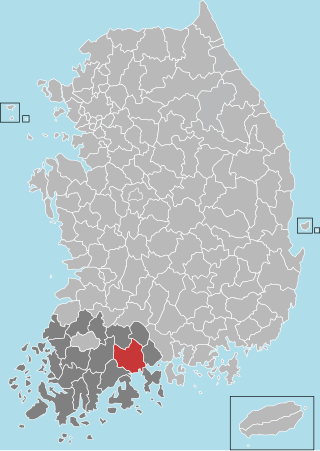
Suncheon (Suncheon-si) is the largest city in Jeollanam-do, South Korea, with a population of 280,719 as of 2022. It is located in the southeast of the province and is a scenic agricultural and industrial city, known for tourist attractions, such as Suncheon Bay. The port city of Yeosu is around forty minutes south of Suncheon and Gwangyang twenty minutes to the east of the city.
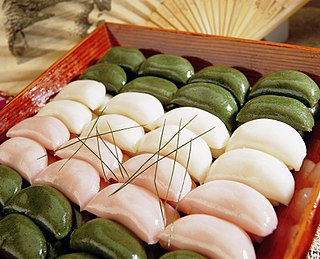
Chuseok, also known as Hangawi, is a major mid-autumn harvest festival and a three-day holiday in South Korea celebrated on the 15th day of the 8th month of the lunar calendar on the full moon. In North Korea, they only celebrate for the day of chuseok. Like many other harvest festivals around the world, it is held around the autumn equinox, i.e. at the very end of summer or in early autumn. It is the biggest traditional holiday in South Korea.

Ansan is a city in Gyeonggi Province, South Korea. It lies southwest of Seoul and is part of the Seoul National Capital Area. It is connected to Seoul by rail via Seoul Subway Line 4. It is situated on the Yellow Sea coast and some islands lie within its jurisdiction. The largest and best-known of these is Daebu Island.
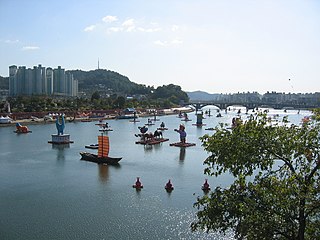
Jinju is a city in South Gyeongsang Province, South Korea. It was the location of the first (1592) and second (1593) Sieges of Jinju by Japanese forces during the Imjin War. The Republic of Korea Air Force Education and Training Command is located in the eastern part of the city. There are cultural-historical tourist attractions in Jinju such as Jinju Castle, the Jinju National Museum, and the Nam-gang Prehistoric Site Museum.

The history of Asian art includes a vast range of arts from various cultures, regions, and religions across the continent of Asia. The major regions of Asia include Central, East, South, Southeast, and West Asia.

Woodblock printing or block printing is a technique for printing text, images or patterns used widely throughout East Asia and originating in China in antiquity as a method of printing on textiles and later paper. Each page or image is created by carving a wooden block to leave only some areas and lines at the original level; it is these that are inked and show in the print, in a relief printing process. Carving the blocks is skilled and laborious work, but a large number of impressions can then be printed.

Korean arts include traditions in calligraphy, music, painting and pottery, often marked by the use of natural forms, surface decoration and bold colors or sounds.
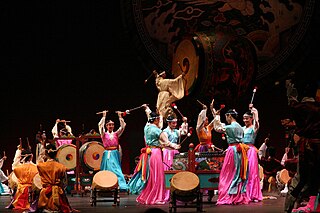
Dance in Korea began with shamanistic early rituals five thousand years ago and now ranges from folk dance to newly created and adopted contemporary dance.

Yeongdeungpo District is an administrative district in southwest Seoul, South Korea. Although the origin of the name is uncertain, the first two syllables are thought to be from "yeongdeung" (靈登) or "divine ascent", a shamanic rite. The third syllable is "po", representing the bank of a river (浦), referring to the district's position on the Han River. The 2006 population was 408,819.
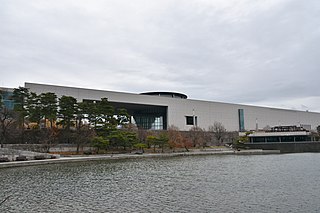
The National Museum of Korea (Korean: 국립중앙박물관) is the flagship museum of Korean history and art in South Korea. Since its establishment in 1945, the museum has been committed to various studies and research activities in the fields of archaeology, history, and art, continuously developing a variety of exhibitions and education programs.

Printing in East Asia originated from the Han dynasty in China, evolving from ink rubbings made on paper or cloth from texts on stone tables used during the Han. Printing is considered one of the Four Great Inventions of China that spread throughout the world. A specific type of printing called mechanical woodblock printing on paper started in China during the Tang dynasty before the 8th century CE. The use of woodblock printing spread throughout East Asia, and the idea of printing perhaps spread to Europe and the Western World, where German publisher and inventor Johannes Gutenberg improved on the design with the introduction of the mechanical press in the mid-15th century. As recorded in 1088 by Shen Kuo in his Dream Pool Essays, the Chinese artisan Bi Sheng invented an early form of movable type using clay and wood pieces arranged and organized for written Chinese characters. The use of metal movable type was known in Korea by the 13th century during the Goryeo period. In Korea the first movable types date from 1239/1240. A further discovery was made in 2009, and here the types were dated to the year 1377.
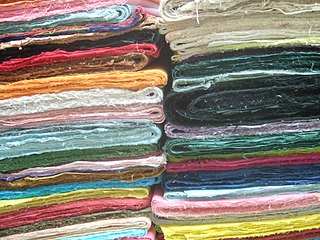
Korean paper or hanji is the name of traditional handmade paper from Korea. Hanji is made from the inner bark of Broussonetia papyrifera known colloquially as paper mulberry, a tree native to Korea that grows well on its rocky mountainsides, known in Korean as dak. The formation aid crucial to making hanji is the mucilage that oozes from the roots of Hibiscus manihot. This substance helps suspend the individual fibers in water.

The National Palace Museum of Korea is a national museum of South Korea located in Gyeongbokgung Palace, Seoul.

Seoul, officially known as the Seoul Special City, is the capital and largest metropolis of the Republic of Korea. According to the 2020 census, Seoul has a population of 9.9 million people, and forms the heart of the Seoul Capital Area with the surrounding Incheon metropolis and Gyeonggi province. Considered to be a global city and rated as an Alpha – City by Globalization and World Cities Research Network (GaWC), Seoul was the world's fourth largest metropolitan economy in 2014, following Tokyo, New York City and Los Angeles.

Uigwe is the generic name given to a collection of approximately 3,895 books recording in detail the royal rituals and ceremonies of the Joseon dynasty of Korea. There is no generally agreed English translation; some scholars suggest "book of state rites", while the Glossary of Korean Studies from the Korea Foundation suggests "manual of the state event" or "rubrica for a state ceremony." The expression "Royal Protocols" is widely used.
Newtro (Hangul:뉴트로) is a portmanteau of the words "new" and "retro", and refers to the trend of "modernized retro". Newtro's beginnings can be traced back to 2018 in South Korea.




















